Why we ran it: To find out how appealing this dynamic family hatch is in its most basic form
Month 4 - Month 3 - Month 2 - Month 1 - Prices and specs
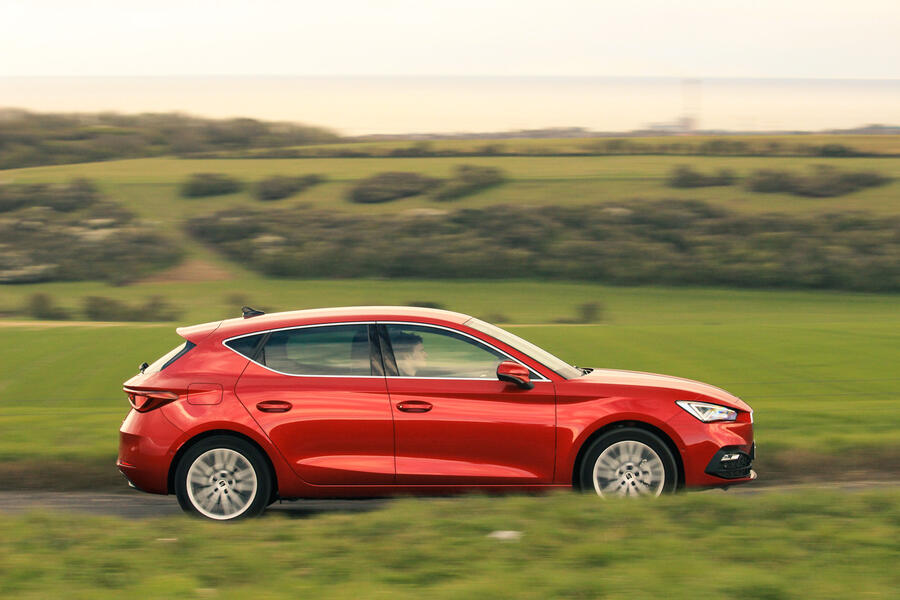
Month 4
We’ve lived with a lower-spec model and a quicker, plusher Seat Leon: which is the better buy and what is Seat's Volkswagen Golf sibling really like? - 21 April 2021
Have you ever experienced a small irritation getting in the way of something that would otherwise be great?
For instance, you’re having a romantic meal with your partner in a fancy restaurant but somebody at a nearby table keeps laughing really obnoxiously. The Smiths’ Bigmouth Strikes Again comes on the radio, but all you can hear is that stupid high- pitched backing vocal. Or you find a family hatchback that looks terrific, is thoroughly enjoyable to drive and is eminently practical but has all of its auxiliary functions on a complex and sometimes frustrating touchscreen.
I am loath to start an article about any car negatively but feel I must do so here because, in the four months since I inherited the running of our long-term Seat Leon, my frustrations with its infotainment system never subsided, even though the car won me over in every other regard.
So let’s get the foibles out of the way ASAP. Above all, replacing physical dials for the temperature, fan speed and air direction with touch-sensitive sliders was a terrible idea, and even more so when those sliders don’t light up in the dark. The time the system takes to load up once the car is started added to the frustration, even if it was only five seconds. And I encountered several glitches, with menus not opening, the heated seats refusing to turn on and a frightful lack of understanding with my faithful iPod (although I should mention that a friend was mightily impressed with the functionality of Android Auto with his new phone).
Right, on to the many positives. I thought the previous 2014-2020 Seat Leon was fantastic, being in essence a cheaper and slightly sportier relation of the Volkswagen Golf, which has long been popularly seen as the perfect family hatchback. The Mk4 Leon is essentially that car refined, using updated versions of its platform and engines, evolved styling (which in my view is improved) and a new interior.
Initial custodian Lawrence Allan started out in a 1.0-litre three-pot turbo petrol making just 108bhp, but he and I had our fears of thrashiness and lethargy satisfactorily allayed. Due to its healthy 148lb ft of turbo torque, this near-entry-level Leon (SE Dynamic trim) never felt like a wheezer, and it averaged around 45mpg during its time with Allan.
I then swapped this for a variant near the other end of the spectrum: a four-pot Seat Leon 1.5-litre turbo petrol, with the trinkets of Xcellence trim, plus a striking Desire Red metallic paint finish, rather than flat Mystery Blue.
It unsurprisingly proved more suited to high jinks, with its 128bhp allowing me to unlock the crispness of its chassis – but what was a surprise was quite how pleasing its six-speed manual gearbox was to use. It really satisfyingly snicked through the gates, making the whole experience much more enjoyable. Certainly, the contrast with the numb wobbler in my previous long-termer, a Peugeot 2008, stood out. The steering was nicely weighted, too, albeit predictably numb.
Therefore, I often was inspired to take the scenic route home from my ‘social bubble’ to blow away the cobwebs. I really would like to get my hands on the FR model, with its Sport driving mode and firmer suspension, let alone the 306bhp Cupra Leon hot hatch (although that sadly is limited to a dual-clutch automatic gearbox). My only real criticism was the fairly poor fuel economy, although that was possibly affected by my usually enthusiastic style (given that lockdown so limited my driving opportunities) and the car being used almost exclusively for short A-road blasts and inner-city crawls.
I could feel some nasty thumps as I went over large potholes as well, but this was rare and the ride otherwise presented no cause for concern. Although firm, it was still as comfortable as I could have wished for. No doubt the more sophisticated multi-link rear set-up of more powerful models would only enhance this impression.
The comfort element also stretched to the driver’s seat. It was fine in the lesser Leon, but Xcellence trim took it to another level, with good bolstering and electric adjustment, including for lumbar support. Heated seats and a heated steering wheel made the winter more bearable to boot.
My few passengers, one of them taller than 6ft, were quite happy as well, even on one occasion when we had crammed three adults, all of our luggage and a mountain bike for a 190-mile journey. Who says families need to have an SUV? Not me.
We began this test to discover which end of the unusually expansive variant spectrum best suits the Leon. Frankly, it impressed me at both ends but the extra power squeezed sweet extra juice from this ripe fruit.
I really would like to recommend it as strongly as I once did the Mk3 Leon. But I just can’t get past that obnoxious laugh or high-pitched backing vocal. I hear them in the new Golf and new Skoda Octavia as well. And so the Ford Focus and Audi A3 Sportback would now be my family hatchback picks for budgets of £21k and £27k. It’s a bit of a shame, that.
Second Opinion
Infotainment gripes aside, the Leon is an attractive alternative to the ‘safe bet’ VW Golf. I found the entry-level 1.0-litre triple charmingly buzzy and plenty poky enough in daily driving, and a well-rounded chassis set-up means the Leon is a smooth operator in town, but engaging out of it.

Felix Page
Love it:
Powertrain and chassis The 1.0 TSI felt far from desperate despite its meagre output, and then I had a whole lot of fun in the 1.5 TSI.
Practically perfect Three adults, all their luggage and a mountain bike on a 190-mile drive: for the Leon, that was no problem.
Looking sharp In this generation, I feel the Leon is now finally level with its Volkswagen Golf cousin in the beauty contest.
Loathe it:
Temperature sliders Annoying at their best, infuriating at their worst. There’s absolutely nothing wrong with rotary dials.
Touchscreen It’s neither convenient nor safe to be forced to look away from the road so much, and it didn’t run perfectly.
Final mileage: 1269
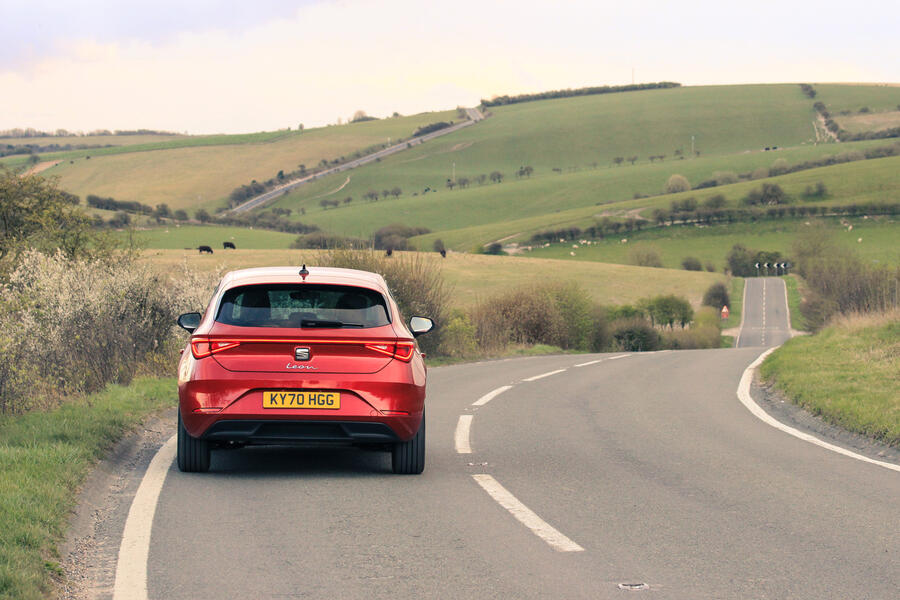
Almost entirely digital interface is proving far from impressive - 14 April 2021
Volkswagen's CEO recently said that the company plans to reveal “our software dream car” in 2026. If my new Seat Leon is anything to go by (not an unfair assumption, given that it shares its digital dashboard with the new Volkswagen Golf), that could be our software nightmare car.
I’m very wary of the growing trend of physical controls being moved onto touchscreens. The manufacturers’ rationale is that this way is simpler, is more modern and allows for over- the-air software updates. I suspect that it cuts production costs, too.
Is it practical in reality, though? Not in my experience, no. It was frustrating and distracting enough having to tap the screen in my Peugeot 2008 to alter the temperature or fan speed, but the Leon makes that look a breeze. It has touch-sensitive ‘sliders’ that don’t light up at night and sometimes stop at 21.5 when I try to withdraw at 19.0. Its front zones don’t synchronise by default, making me open a menu. (This same menu is needed for the seat heating.) And despite the screen being 10.0in, the icon for turning the air-con on or off is no bigger than a fingernail. To top it all off, on a recent journey, that menu refused to open.
Any more? Oh yes: neither the USB nor the Bluetooth will agree with my 2017 iPod. So sorry, mum and dad, but I really can’t skip this Kendrick Lamar song. And the sat-nav believes all postcodes are ‘off-road’. Helpful.
Finally, after I deactivate the lane- keeping assistance, which defaults to on, the digital dials don’t revert to my chosen layout. Another six presses...
You might be thinking that I must be some fuddy-duddy technophobe. Nope: I’m the same age as the Lotus Elise. This simply isn’t good enough.
Mileage: 855
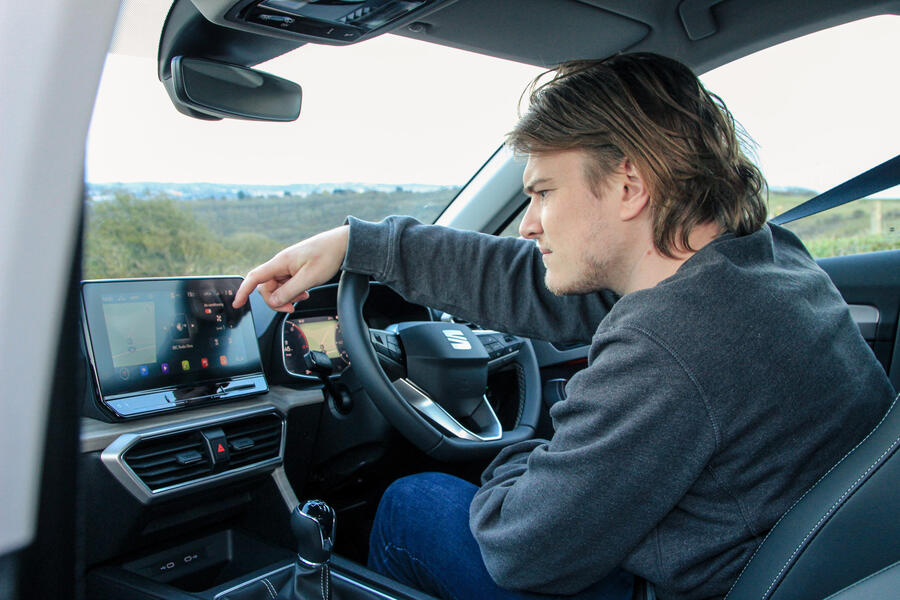
Driver engagement than an EV can’t match - 7 April 2021
The Leon has reminded me how fun an everyday car can be, following a period running an electric SUV. On the way back from my ‘social bubble’, I now go the long way to enjoy some South Downs scenery (ahem) that I know like the back of my hand. Isn’t it a thrill to have a manual ’box and a nice petrol engine? Chassis ain’t half bad either. Bet the FR is a corker.
Mileage: 777
Life with a Seat Leon: Month 3
We’ve swapped our no-frills 1.0 TSI hatchback for a posh 1.5 TSI - 24 March 2021
Pastures new have greeted Lawrence Allan, so the task of comparing the two ends of the new Seat Leon range has fallen to me.
I had a week driving his Leon, a Mystery Blue hatchback in SE Dynamic trim (the second rung up a ladder of six) and with the 108bhp 1.0-litre four-pot turbo petrol engine, before a posher model took its place.
“I bet you’ll get a bit of a shock when you put your foot down for the first time and nothing happens,” Allan joked as I stepped out of my torque-crazy electric Peugeot e-2008, but even this most basic of Leon powertrains didn’t really feel underpowered for what would be a family runaround.
Unless you’re the kind of person who is always in a hurry. I was one of those people back when I had a life, so I must confess that the extra 28bhp of my new Desire Red 1.5-litre turbo petrol Leon was welcome. If buying for myself, I might even have been tempted by the additional 20bhp offered for £770.
There’s an impressive variety of powertrains available in the Leon, you see – the others being a mild-hybrid version of the 1.0 TSI; a 113bhp 2.0-litre diesel; and a 1.4 TSI petrol-electric plug-in hybrid with 201bhp and a 40-mile electric-only range.
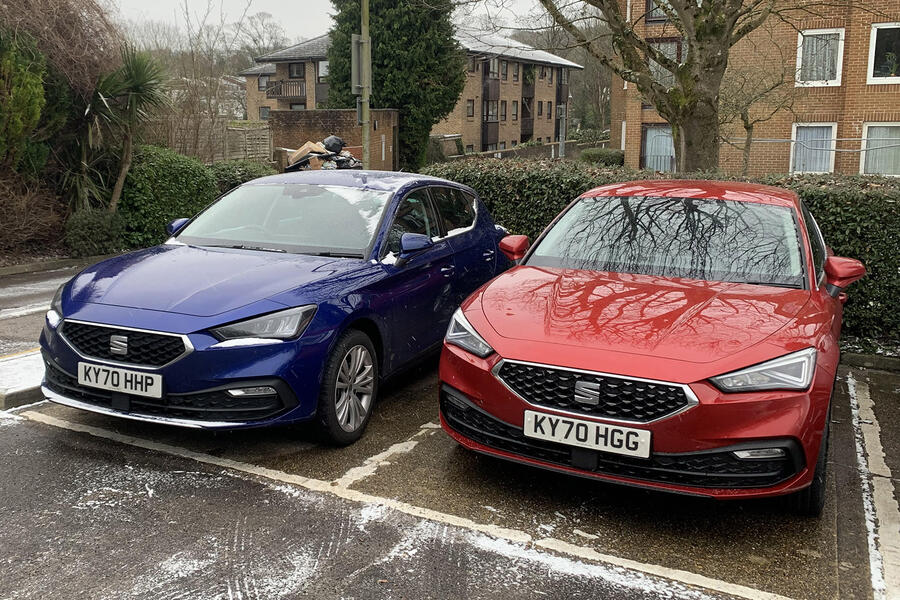
You can order a dual-clutch automatic gearbox, but my Leon has a six-speed manual, which I’m very happy about. How lovely it is to use: it reminds me more of the Mazda MX-5’s, with its gratifyingly precise action, than the numb, wobbly, cube-topped lever in my old Peugeot 2008.
The 1.0 TSI Leon was satisfying to drive, and it has been the same story with the 1.5 TSI; that sweet gearbox, the modest engine, keen chassis and taut steering combine to make this an enjoyable car with which to exploit inviting country roads. The Leon is positioned as the more exciting sister of the Volkswagen Golf, and it shows.
This Leon is in Xcellence trim, which Seat calls “the indulgent one”. Indeed, it’s enhanced with a reversing camera and keyless entry and start in addition to the fullLED lights, scrolling indicators, four selectable driving modes, ‘microsuede’ upholstery, tri-zone climate control, seat heating, heated leather steering wheel, rain-sensing wipers, wireless phone charger, ambient interior lighting, electric adjustment for the driver’s seat, manual height adjustment for the front passenger seat and adjustable lumbar support for both that are added by the FR and FR Sport trims below. It’s hard to argue with Seat’s claim that it “oozes class”, regardless of how much that verb makes me shudder.
For the record, range-topping Xcellence Lux trim adds leather seats, hands-free tailgate opening, high-beam assistance and adaptive cruise control. Honestly, I’m happy to miss out on those first three things and delighted to avoid the last one.
Has the Leon made a good first impression, then? Hmm. ‘Mixed’ would be the best descriptor. At least my bad feelings come from a single source: the infotainment. To my chagrin, the first thing I noticed was the lack of dashboard buttons and, worse still, the touch-sensitive sliders for the temperature and volume that had so irritated me in the new Golf, beneath the same 10.0in touchscreen.
My fingers are crossed in the hope that an extended period can change my first impression of this being the old Leon – of which I was a big fan – made better to drive and more efficient but with an inferior interior.
Love it:
Family car fun Running an electric SUV, I forgot how fun a family car can be. The Leon’s engine, gearbox, steering and chassis make a great team.
Loathe it:
Temperature sliders Why can’t I have a dial to adjust the temperature? One to, you know, use reliably in the dark and without looking away from the road.
Mileage: 625
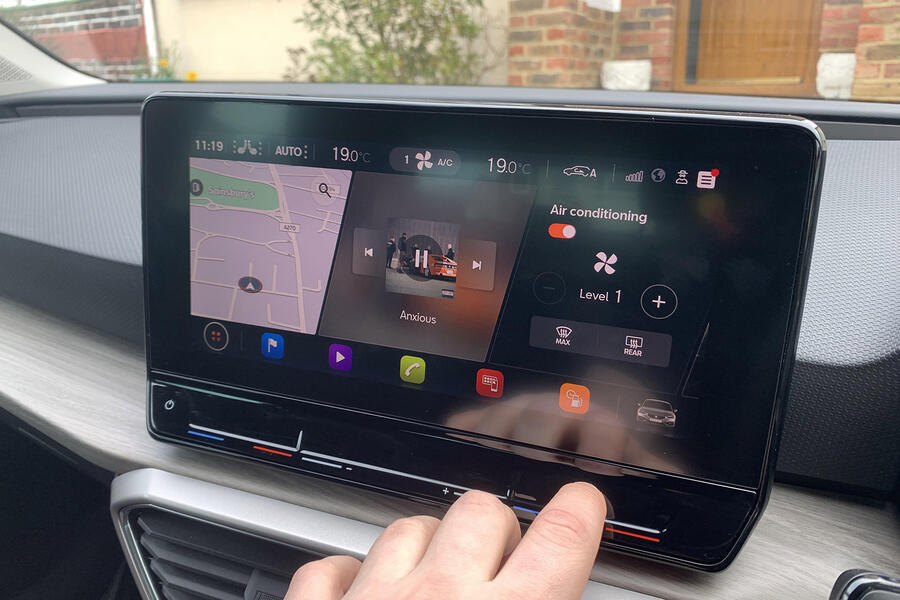
Life with a Seat Leon: Month 2
Change of custodian - 17 February 2021
I’ve now given the Leon to chief sub- editor Kris Culmer, and my time with it went all too quickly. Restrictions meant I couldn’t drive it as much as I would’ve liked, but on the rare longer trips I did get to make, it impressed me with its general competence and frugality. Kris will enjoy more bells and whistles (and power) as we swap into a higher trim grade soon.
Mileage: 2632
Subtle changes compared to old model - 27 January 2020
The Mk4 Leon’s styling evolution seemed distinctly less subtle next to a same-colour 2013-2020 Seat Leon Mk3 during an impromptu Tesco twin test. Seat’s new-look front end is more distinguishable from other VW Group models, and the introduction of a few angles here and there has injected welcome aggression to the stance. I admired this older car’s five-spoke alloys, though, which look less fussy than our car’s 15-spoke items.
Mileage: 2233

How does our no-frills car compare with an entry-level Golf? - 13 January 2020
It’s quite telling that even my friends who have little knowledge of or interest in cars know that a Seat Leon is “basically a Golf” underneath. It seems decades of platform sharing has a downside in that you become notorious for it, even though essentially everybody is doing it these days.
But I had a feeling that in the Volkswagen Group’s cost-sensitive, post-Dieselgate era, its genetic homogeneity between brands was more obvious than ever. So when we had a comparable Volkswagen Golf booked in, I leapt at the chance to get them together for closer examination.
The 1.0-litre Life model we have here is the lowest rung of the Golf ladder. But even that is £3000 more than the cheapest Leon powered by the same engine, and £1800 or so more than our middling SE Dynamic model. Overpriced for a ‘boggo’ trim? Possibly, but the VW is actually better equipped than our Seat.
It shares the larger touchscreen and digital instruments of our Leon but adds features such as multicolour ambient lighting, puddle lights in the mirrors, adaptive cruise control and lumbar adjustment. Although both cars feature LED main lights all round, only the Golf has a ‘coming and leaving home’ feature – a major omission from our Leon, I reckon. Simple features such as a front and rear armrest are present, too, unlike in the Leon. The one thing the Golf doesn’t have that it needs is larger wheels: those 16in items look pretty lost in its arches.
There’s no doubt in my mind, though, that the Golf is a nicer place to sit. Sure, the basic dashboard architecture and infotainment are the same, but there’s a greater feeling of perceived quality, plushness and material variety, and the ambient lighting adds to the sense of it being a class above, for me. The Leon looks and feels that bit more workaday, with fewer soft-touch elements and, in our long-term test car at least, more niggling trim rattles that are emerging in the cold weather.
Dimensionally, there’s a hair’s breadth between them, so both are impressively roomy for the class. But the Leon lacks a height-adjustable boot floor and underfloor storage, both of which are present in the Golf and expected these days.
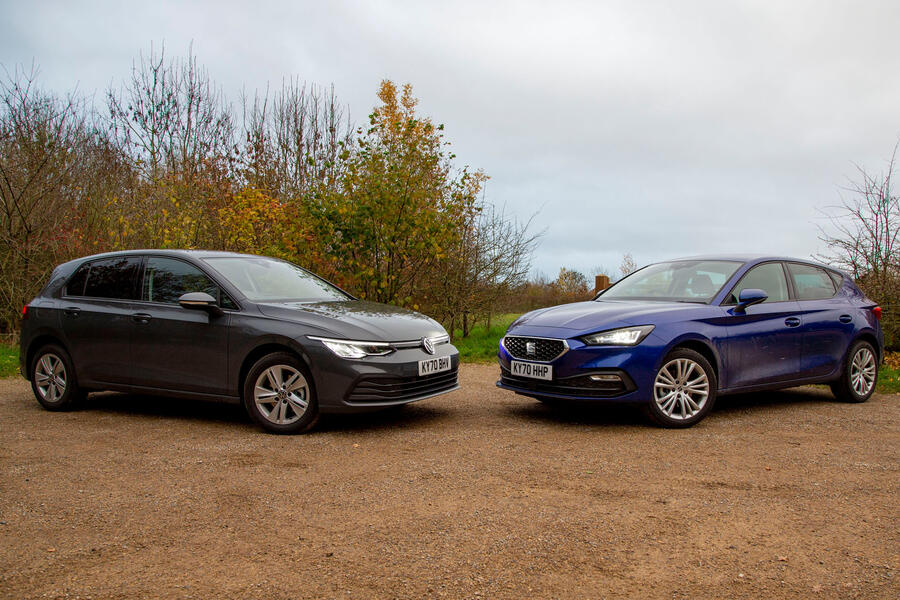
Each of the two brands has cleverly tailored its car’s driving experience to suit its target audience, too. Seat, whose buyers are said to be the youngest of any VW Group brand, has firmed the damping and sharpened the steering response a touch, giving the Leon tighter body control and a keener turn-in without sacrificing too much to comfort.
The Golf, by contrast, feels looser and less direct in the bends (although still composed enough) but counters with a more plushly damped ride and more insulation to reduce road noise.
Unsurprisingly, both engines behave identically, although the Golf’s unit is again slightly better insulated from the cabin. Oddly, given both have identical power and torque figures and weigh about the same, VW quotes a 4mph higher top speed and slightly quicker 0-62mph time than Seat does for the Leon. Is it down to aerodynamics and tuning? Or is it a case of the Golf having to be seen to be ‘better’ to justify the price? Part of me suspects it’s the latter.
Better on paper the Golf may be, but could I justify spending the extra? Personally, no. What I’d do is use it to get a better spec of Leon.
Love it:
How it looks The Golf may be nicer inside, but I much prefer the Leon’s sharper exterior.
Loathe it:
Penny pinching Base-model omissions such as the lack of any centre armrests are a bit mean.
Mileage: 2189
Doesn’t see the light - 6 January 2020
A reader emailed me to express his displeasure that the new Leon SE Dynamic he had ordered (like ours) doesn’t come with the full-width LED tail-light strip that higher trims do. I can understand Seat wanting to walk buyers up the trim ladder, but to omit a key part of the rear-end design is a shame. The low-mounted third brake light in its place looks odd.
Mileage: 1925
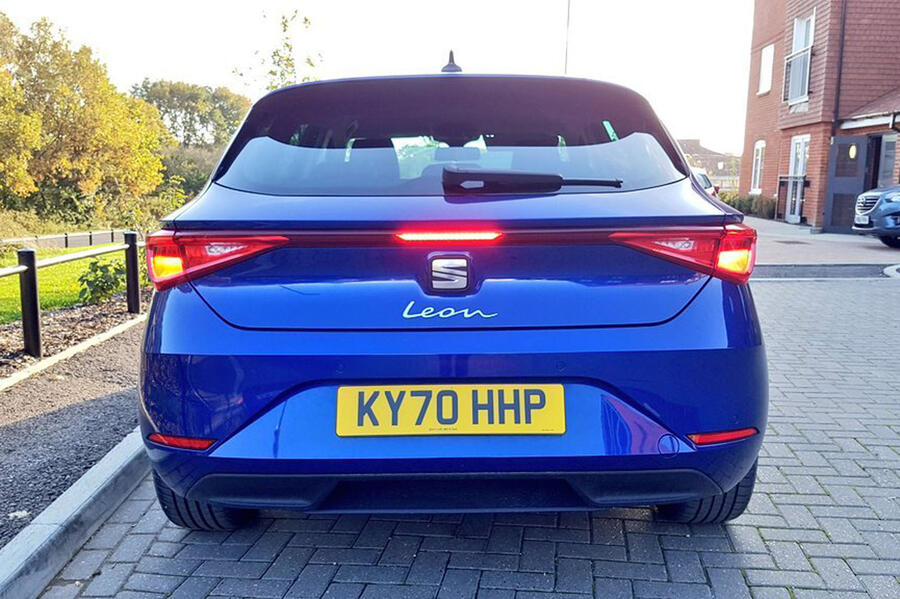
Life with a Seat Leon: Month 1
Too much safety information - 2 December 2020
I don’t get on with the Leon’s lanekeeping assistance, but that’s the same with most cars. What isn’t the same is that when you turn it off, not one but two warning lights come on: a subtle one in the instruments and a bright orange triangle beside the binnacle. This is so distractingly visible in the dark that I’ve resorted to covering it with electrical tape.
Mileage: 1275
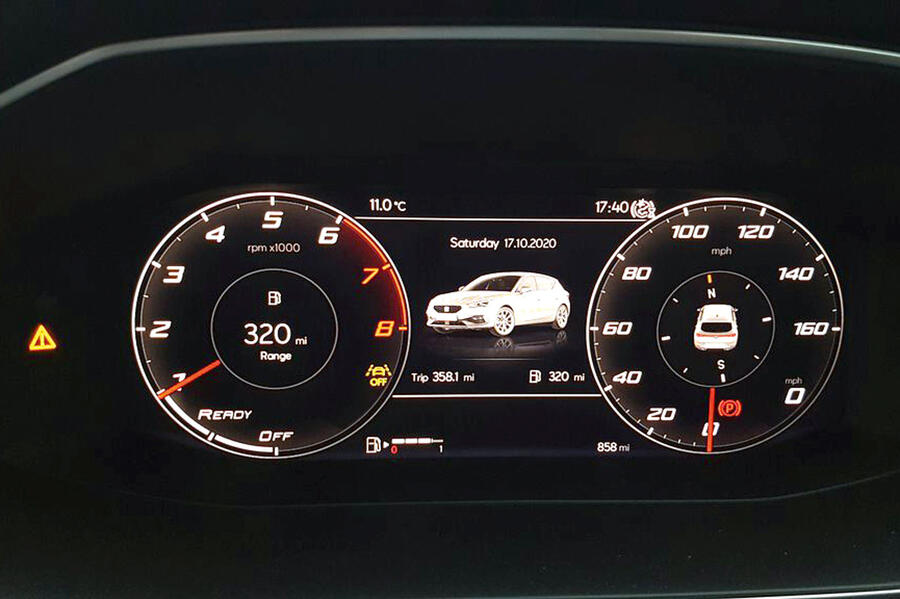
Welcoming the Leon to the fleet - 25 November 2020
It rarely escapes your notice that we tend to find ourselves in high-spec test cars. But it’s not usually our fault.
Manufacturers generally prefer us to try the all-singing, all-dancing models with every conceivable feature or a vast array of options, so that’s the kind of car they often provide us with.
Their reasoning is twofold. Of course, it means the car in our pictures is the most desirable it can be. But it also gives us something to talk about and lets us work out which options are worth speccing or not. For our latest long-term test car, though, things are simpler: Seat has sent us what can unkindly be called a ‘boggo’ version of its new-generation Leon to get to know.
All right, so our SE Dynamic car is one rung up from entry level, but it does use the entry engine: a 108bhp 1.0-litre three-cylinder petrol with no mild-hybrid tech in sight. Even more unusually for a press car, it doesn’t have a single option. Even metallic paint is a no-cost addition.
So while expectations will be kept in check, it’s often quite endearing to drive a modestly specced, small-wheeled, low-powered variant – particularly one with a manual gearbox, as we have here. We’ll also be moving up the range in a few months to see if the additional expense is worth it.
But back to this Leon. At a smidge under £21k (a price we’re becoming used to seeing on superminis these days), it’s a decent amount of car for modest cash. Yet it’s not too utilitarian inside, featuring the larger, 10.0in touchscreen with satellite navigation and voice control, the digital cockpit, climate and cruise control, LED headlights, keyless start and even park assist (alongside front and rear sensors).
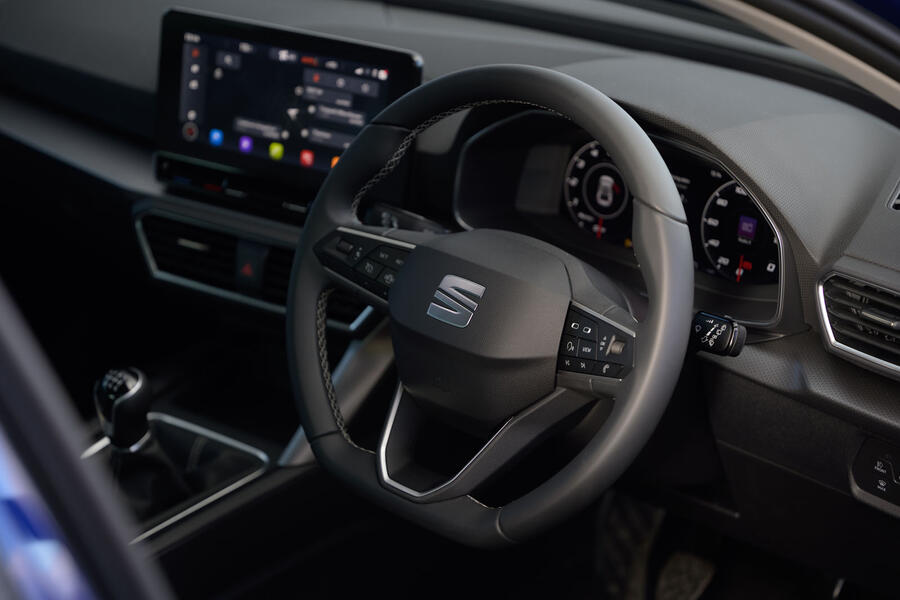
There’s no nasty plastic wheel and gearknob, as both are stitched in leather. There’s also a suite of safety tech, including lane keep assist and front assist. In short, it ticks the boxes customers expect it to, and a few more besides.
Or does it? Maybe my expectations are different from those of typical buyers, but there are a few missing features that I’d consider pretty fundamental for any £20k-plus hatchback. Things such as coming and-leaving-home lighting, a central armrest and even a rear armrest-cum-ski hatch are made conspicuous by their absence. All three are added on higher trims, such as FR, but frankly are far more of a priority to me than any self-parking wizardry.
No Leon has a variable boot floor, either, meaning a big hump to lift stuff over when the seats are folded. It’s becoming increasingly apparent that to satisfy Euro NCAP assist tech regulations and still keep the gadgets customers expect at a palatable price, some makers are resorting to ever more visible cost trimming.
Anyway, moan over. A few missing essentials on this spec aside, the Leon’s cabin is comfortable to spend time in and it seems well screwed together for the price. I have no trouble getting my 6ft 3in frame settled in the driver’s seat thanks to a wide range of adjustment. It’s also a more visually appealing design inside (to me, at least) than its predecessor, thanks to the shapely dashboard and mixture of colours and materials, even at this end of the range.
The button-averse minimalism does have some drawbacks, namely of the ergonomic variety. For example, I find the touch-sensitive temperature and volume panel below the screen sometimes needs a second prod to respond. More annoyingly, though, it’s not backlit, so I can’t use it at all at night – a bizarre oversight. At least the touchscreen is one of the more responsive and intuitive to operate that I’ve tried at this price point.
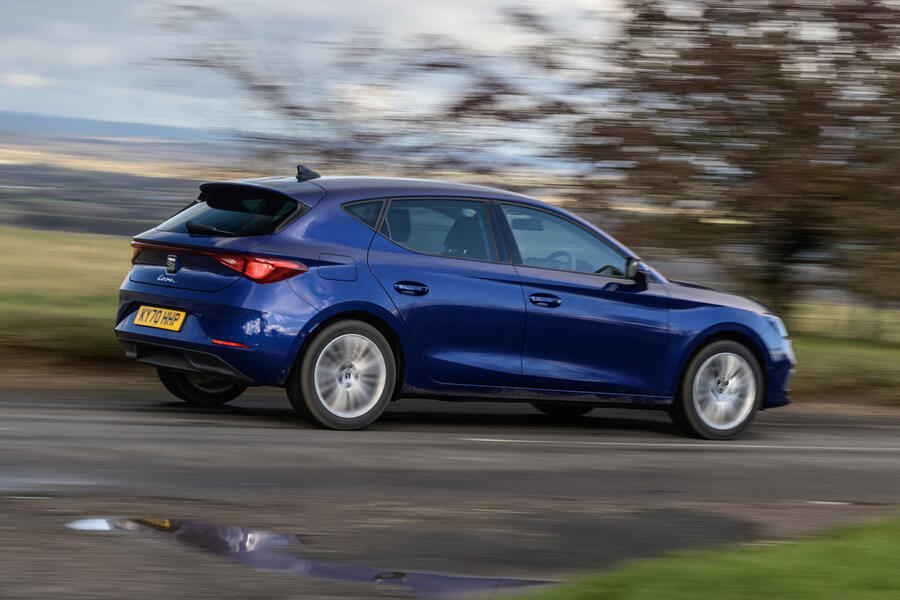
After the storming performance of my previous Audi S5 long-termer, I was concerned that this 108bhp Leon would feel thrashy and underpowered in comparison. In fact, it’s far from it. First, because noise and vibration levels – a common three-cylinder bugbear – are commendably low, to the point that I’ve sometimes found myself cruising along in a much lower gear than I thought I was in. But also because peak torque – a healthy 148lb ft – comes in at just 2000rpm, making it feel gutsier than it actually is. It causes me to think back to the 2.0-litre Mazda 3 I ran earlier this year, which, despite a much punchier 178bhp, lacked a turbo, leaving you with the impression that it feels more strained at lower revs than this half-capacity Leon.
Fuel economy is hovering around 45mpg so far, which is fine rather than remarkable, and I’ll see if it improves as the car crosses the 1000-mile mark. The manual shift, positive steering and eager engine have resulted in frequent spirited driving, though, so it’s not bad. The Leon is more fun to drive than you might expect for a cheaper model, despite lacking the multi-link suspension of posher versions. I’ll be experiencing that more once lockdown is over.
Second Opinion
Once the opportunity presents itself, I’m sure the Leon’s dynamism will quickly make up for the ‘FOMO’ of a modest kit list. Seat’s family hatchback may not have as refined a ride as the Volkswagen Golf with which it shares a platform, but it feels that little bit more engaging, more alert through the corners, and, to my eyes, it has the edge in terms of styling.
Tom Morgan
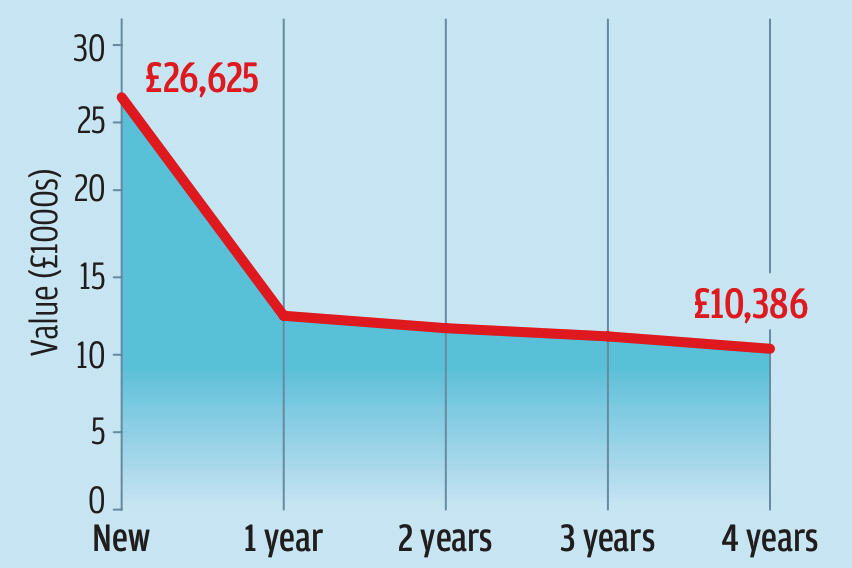




















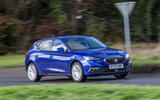




















Join the debate
Add your comment
Just returned one of these to Enterprise, was lent it while my car is in for repair, handed it back after 8 miles, worse car I have ever driven and I have owned over 30 cars plus driven hire cars and various pool cars, wouldn't even give a 1 star rating
How can a company of VAGs might get something as basic as the driver interface wrong.
First time that I have seen mentioned that the temperature and volume controls are not backlit, thats a ridiculous oversight, and considering the Golf uses the same system, is the Golfs backlit, or is it just a SEAT problem.